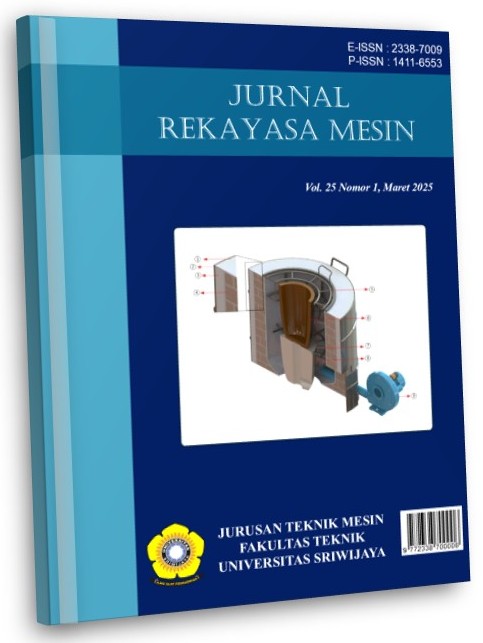Analisis Cacat Penyusutan dan Nilai Kekerasan Produk Cor Aluminium Skrap dengan Variasi Ukuran Mild Steel Cylinder Mold
DOI:
https://doi.org/10.36706/jrm.v25i1.1414Keywords:
casting, Aluminum scrap, molding’s diameter, hardness, shrinkageAbstract
The research was conducted to investigate the effect of mold diameter variation on the hardness and shrinkage of cast products made from aluminum scrap. Three mold diameter variations were used in the casting process: 50 mm, 70 mm, and 100 mm. The testing methods included shrinkage measurement, Brinell hardness testing, and dye penetrant inspection. The test results showed that the 50 mm sample had the highest hardness value of 52.09 BHN and the lowest shrinkage defect of 25.25%, while the 100 mm diameter sample exhibited the lowest hardness value of 48.72 BHN and the highest shrinkage defect of 28%. This phenomenon occurred due to differences in cooling rates during the solidification process, where larger mold diameters experienced slower cooling, resulting in coarser microstructure grains and a higher occurrence of shrinkage defects.
Downloads
References
V. B. Deev et al., “The influence of the melt cooling rate on shrinkage behaviour during solidification of aluminum alloys,” IOP Conf Ser Mater Sci Eng, vol. 537, no. 2, p. 022080, May 2019, doi: 10.1088/1757-899X/537/2/022080.
L. R. Botvina, M. R. Tyutin, and A. P. Alexandrov, “Gigacycle Fatigue of the Turbocharger Gear Wheel,” Inorganic Materials, vol. 59, no. 15, pp. 1571–1580, Dec. 2023, doi: 10.1134/S0020168523150025.
D. S. Wong and P. Lavoie, “Aluminum: Recycling and Environmental Footprint,” JOM, vol. 71, no. 9, pp. 2926–2927, Sep. 2019, doi: 10.1007/s11837-019-03656-9.
C. Windmark, L. Lattanzi, A. Månberger, and A. E. W. Jarfors, “Investigation on Resource-Efficient Aluminium Recycling – A State of the Art Review,” 2022. doi: 10.3233/ATDE220122.
D. Raabe et al., “Making sustainable aluminum by recycling scrap: The science of ‘dirty’ alloys,” Prog Mater Sci, vol. 128, p. 100947, Jul. 2022, doi: 10.1016/j.pmatsci.2022.100947.
L. Zhuo, S. Pang, H. Wang, and T. Zhang, “Effect of cooling rate on microstructure and mechanical properties of rapidly solidified Al-based bulk alloys,” J Alloys Compd, vol. 504, pp. S117–S122, Aug. 2010, doi: 10.1016/j.jallcom.2010.03.211.
Y. Murakami, K. Miwa, M. Kito, T. Honda, N. Kanetake, and S. Tada, “Effect of Casting Condition in Semi-Solid Aluminum Alloy Injection Process on Distribution of Defects and Density,” in Shape Casting: 5th International Symposium 2014, Cham: Springer International Publishing, 2014, pp. 11–18. doi: 10.1007/978-3-319-48130-2_2.
Y. Li, Z. Wang, X. Zhou, H. Xiao, and Q. Yue, “A review of electromagnetic stirring on solidification characteristics of molten metal in continuous casting,” Metallurgical Research & Technology, vol. 121, no. 3, p. 312, May 2024, doi: 10.1051/metal/2024029.
Y. Yu, X. Luo, H. (Yulin) Zhang, and Q. Zhang, “Dynamic optimization method of secondary cooling water quantity in continuous casting based on three-dimensional transient nonlinear convective heat transfer equation,” Appl Therm Eng, vol. 160, p. 113988, Sep. 2019, doi: 10.1016/j.applthermaleng.2019.113988.
Y. Yuan and Z. Li, “Numerical and experimental study of the elimination of shrinkage in complex and small investment castings using water cooling process,” 2013, pp. 805–811. doi: 10.1063/1.4806914.
M. Chasnitsky, V. Yashunsky, and I. Braslavsky, “Heat flux balance description of unidirectional freezing and melting dynamics on a translational temperature gradient stage,” International Journal of Thermal Sciences, vol. 161, p. 106734, Mar. 2021, doi: 10.1016/j.ijthermalsci.2020.106734.
P. I. O’Toole, M. J. Patel, C. Tang, D. Gunasegaram, A. B. Murphy, and I. S. Cole, “Multiscale simulation of rapid solidification of an aluminium–silicon alloy under additive manufacturing conditions,” Addit Manuf, vol. 48, p. 102353, Dec. 2021, doi: 10.1016/j.addma.2021.102353.
A. Kapil, V. Sharma, J. De Pauw, and A. Sharma, “Exploring impact, spreading, and bonding dynamics in molten metal deposition for novel drop-on-demand printing,” Mater Des, vol. 238, p. 112633, Feb. 2024, doi: 10.1016/j.matdes.2024.112633.
Downloads
Published
How to Cite
Issue
Section
License
Copyright (c) 2025 Jurnal Rekayasa Mesin

This work is licensed under a Creative Commons Attribution-ShareAlike 4.0 International License.
Jurnal Rekayasa Mesin (JRM) memberikan akses terbuka terhadap siapapun agar informasi dan temuan pada artikel tersebut bermanfaat bagi semua orang. Semua konten artikel Jurnal ini dapat diakses dan diunduh secara gratis, tanpa dipungut biaya, sesuai dengan lisensi creative commons yang digunakan.





















